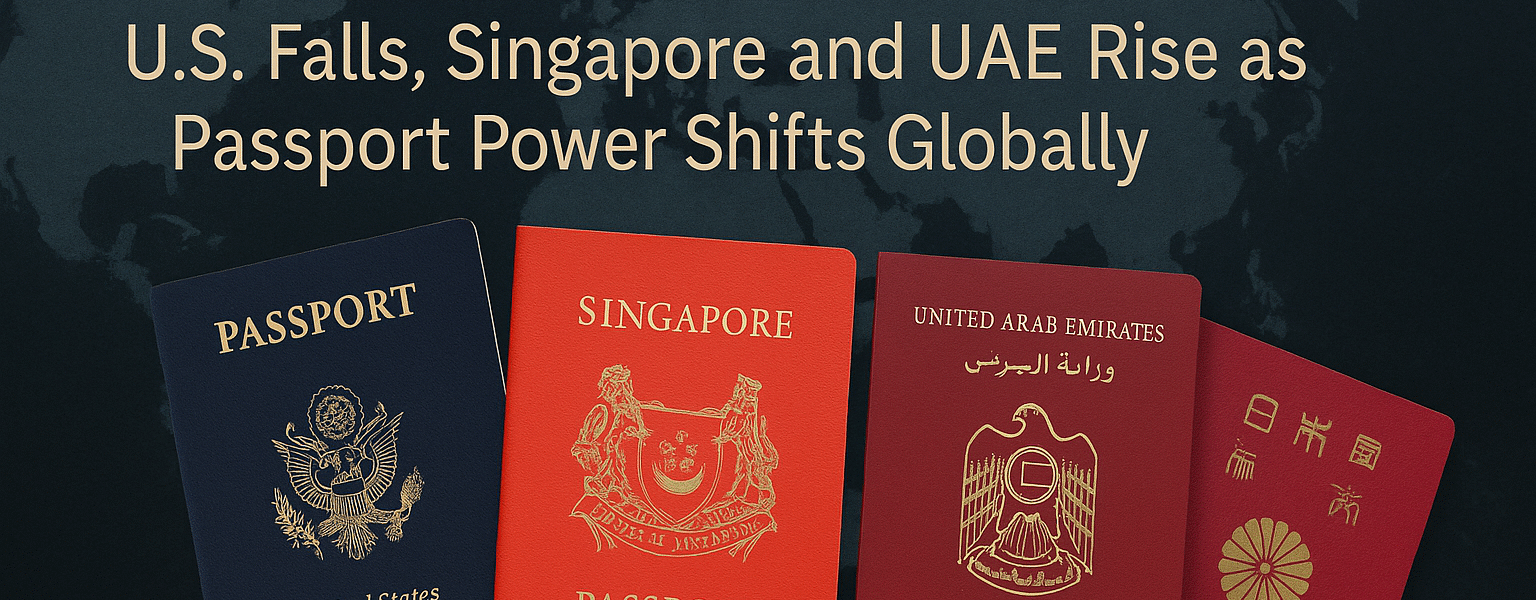Passport Index 2025 Shock: U.S. Falls, Singapore and UAE Rise as Passport Power Shifts Globally
The world’s most powerful passport index 2025 — who leads, who lags, and how “power” is measured
Asia holds the crown in 2025. Singapore tops the Henley Passport Index this year, with visa-free/visa-on-arrival access to 193 destinations. South Korea sits second (190), followed by Japan (189). A broad mix of European passports fills out the rest of the top tier. In a landmark shift, the United States has fallen out of the global top 10 for the first time, dropping to 12th, tied with Malaysia in terms of access. Afghanistan, Syria and Iraq remain at the very bottom with the fewest destinations available without a pre-arranged visa.
India’s position serves as a useful bellwether for the broader Global South. In Henley’s 2025 list, India ranks 85th, with around mid-50s visa-free/VOA access (Indian outlets summarise Henley’s detailed tables as 57 destinations). The contrast with the top group underscores the widening gap in mobility privileges.
Wait—why do some outlets say the UAE is No. 1?
Because there are different indices with different methods:
- Henley Passport Index (used above) counts how many places a passport holder can enter without a prior visa (visa-free or visa-on-arrival/eTA), using IATA airline/immigration data. Its 2025 release puts Singapore first and the U.S. at 12th.
- Arton Capital’s Passport Index is a real-time dashboard that computes a Global Mobility Score and includes eVisas (if issued in <3 working days). On this measure in 2025, the United Arab Emirates is ranked the most powerful (Mobility Score ~173), while Afghanistan is last (~30). That’s why you’ll see “UAE No. 1” headlines alongside Henley’s “Singapore No. 1.
Bottom line: both indices try to capture how easily a passport lets you move, but they don’t weigh the same things (e.g., treatment of eVisas, update cadence), so their league tables can differ.
E Passport India Revolution: A Game-Changer for Secure and Hassle-Free International Travel
2025 Passport Index: Key movers and storylines
- U.S. slide becomes historic. After topping Henley passport Index in 2014, the American passport continues a long drift to 12th in 2025—Henley links this to a tougher global visa environment and policy choices that haven’t translated into additional reciprocal access.
- Asia-Pacific dominance persists. Singapore, South Korea and Japan anchor the top of Henley’s table; European Schengen members cluster close behind.
- India’s incremental progress stalls in the Henley passport index. Despite booming outbound travel and a patchwork of ETAs/VOAs, India’s access count keeps it mid-table at 85th this year.
- At the bottom, little relief. Afghanistan remains the world’s least accepted passport across both Henley and Arton, with Syria and Iraq also in Henley’s bottom three.
How “passport power” is actually assessed
- Core metric: Count of destinations a passport holder can enter without obtaining a visa in advance—i.e., visa-free, visa-on-arrival or eTA. Henley builds its list from IATA data and its research team; Arton compiles from official public sources and government sites, and also treats fast eVisas as part of mobility.
- Update cadence: Henley publishes quarterly reports; Arton updates in real time, so temporary changes and new bilateral deals can show up faster.
- What’s not captured: These rankings don’t measure how long you can stay, work rights, processing friction at the border, or the quality of destinations. That’s why two passports with similar counts can feel very different in practice.
Why some countries climb the ladder
- Visa-waiver diplomacy. Sustained outreach—especially with Schengen, the UK, and East Asia—yields step-wise gains in counts. Singapore and South Korea are years into this playbook; Gulf states (notably the UAE in Arton’s ranking) leveraged aggressive bilateral deals and digital entry systems to leap ahead.
- Digital entry systems (ETAs/eVisas). Countries that roll out reliable ETAs and accept them reciprocally multiply low-friction access and can climb quickly on Arton’s live index.
- Security/trust outcomes. Improvements in border security, document standards, and overstay records help win waivers; conflict or sanctions do the opposite—hence the persistent bottom grouping.
The least accepted passports in 2025
- Henley (2025): Afghanistan (fewest destinations), followed by Syria and Iraq.
- Arton (2025): Afghanistan has the lowest Mobility Score (≈30).
Conclusion
In 2025, global mobility is bifurcated. On Henley’s widely cited passport Index benchmark, Singapore remains No. 1 while the U.S. makes history by dropping out of the top ten—signalling that past prestige doesn’t guarantee present-day access. On Arton’s live index, the UAE showcases how targeted diplomacy and digital visas can vault a country to the top. At the other end, Afghanistan and war-torn states face entrenched barriers. The headline lesson: passport power is policy-driven and dynamic—nations that proactively pursue visa-waiver deals, modernise entry systems, and build trust can climb; those mired in conflict or isolation slip further behind. For travellers and policymakers alike, that makes 2025 a year to watch not just the rankings, but the rules behind them.
Passport Index 2025, World’s most powerful passports 2025, Global passport ranking 2025, Strongest passports in the world 2025, Henley Passport Index 2025, Arton Passport Index 2025 , Singapore passport 2025, UAE passport ranking 2025, U.S. passport ranking 2025, India passport ranking 2025, Least powerful passports 2025, Global mobility score 2025, Visa free countries 2025, Travel freedom 2025, Which country has the most powerful passport 2025, How is passport power measured, Countries with most visa-free access 2025, Passport Index comparison 2025, Global travel ranking 2025
Discover more from
Subscribe to get the latest posts sent to your email.







